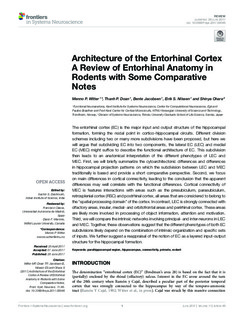| dc.contributor.author | Witter, Menno | |
| dc.contributor.author | Doan, Thanh Pierre | |
| dc.contributor.author | Nilssen, Eirik Stamland | |
| dc.contributor.author | Jacobsen, Bente | |
| dc.contributor.author | Ohara, Shinya | |
| dc.date.accessioned | 2017-12-13T12:17:12Z | |
| dc.date.available | 2017-12-13T12:17:12Z | |
| dc.date.created | 2017-06-17T07:05:23Z | |
| dc.date.issued | 2017 | |
| dc.identifier.citation | Frontiers in Systems Neuroscience. 2017, 11:46. | nb_NO |
| dc.identifier.issn | 1662-5137 | |
| dc.identifier.uri | http://hdl.handle.net/11250/2471168 | |
| dc.description.abstract | The entorhinal cortex (EC) is the major input and output structure of the hippocampal formation, forming the nodal point in cortico-hippocampal circuits. Different division schemes including two or many more subdivisions have been proposed, but here we will argue that subdividing EC into two components, the lateral EC (LEC) and medial EC (MEC) might suffice to describe the functional architecture of EC. This subdivision then leads to an anatomical interpretation of the different phenotypes of LEC and MEC. First, we will briefly summarize the cytoarchitectonic differences and differences in hippocampal projection patterns on which the subdivision between LEC and MEC traditionally is based and provide a short comparative perspective. Second, we focus on main differences in cortical connectivity, leading to the conclusion that the apparent differences may well correlate with the functional differences. Cortical connectivity of MEC is features interactions with areas such as the presubiculum, parasubiculum, retrosplenial cortex (RSC) and postrhinal cortex, all areas that are considered to belong to the “spatial processing domain” of the cortex. In contrast, LEC is strongly connected with olfactory areas, insular, medial- and orbitofrontal areas and perirhinal cortex. These areas are likely more involved in processing of object information, attention and motivation. Third, we will compare the intrinsic networks involving principal- and inter-neurons in LEC and MEC. Together, these observations suggest that the different phenotypes of both EC subdivisions likely depend on the combination of intrinsic organization and specific sets of inputs. We further suggest a reappraisal of the notion of EC as a layered input-output structure for the hippocampal formation. | nb_NO |
| dc.language.iso | eng | nb_NO |
| dc.publisher | Frontiers Media | nb_NO |
| dc.rights | Navngivelse 4.0 Internasjonal | * |
| dc.rights.uri | http://creativecommons.org/licenses/by/4.0/deed.no | * |
| dc.title | Architecture of the entorhinal cortex A review of entorhinal anatomy in rodents with some comparative notes | nb_NO |
| dc.type | Journal article | nb_NO |
| dc.type | Peer reviewed | nb_NO |
| dc.description.version | publishedVersion | nb_NO |
| dc.source.volume | 11 | nb_NO |
| dc.source.journal | Frontiers in Systems Neuroscience | nb_NO |
| dc.identifier.doi | 10.3389/fnsys.2017.00046 | |
| dc.identifier.cristin | 1476823 | |
| dc.description.localcode | Copyright © 2017 Witter, Doan, Jacobsen, Nilssen and Ohara. This Document is Protected by copyright and was first published by Frontiers. All rights reserved. It is reproduced with permission. This is an open-access article distributed under the terms of the Creative Commons Attribution License (CC BY). | nb_NO |
| cristin.unitcode | 194,65,60,0 | |
| cristin.unitname | Kavliinstitutt for nevrovitenskap | |
| cristin.ispublished | true | |
| cristin.fulltext | postprint | |
| cristin.qualitycode | 1 | |

